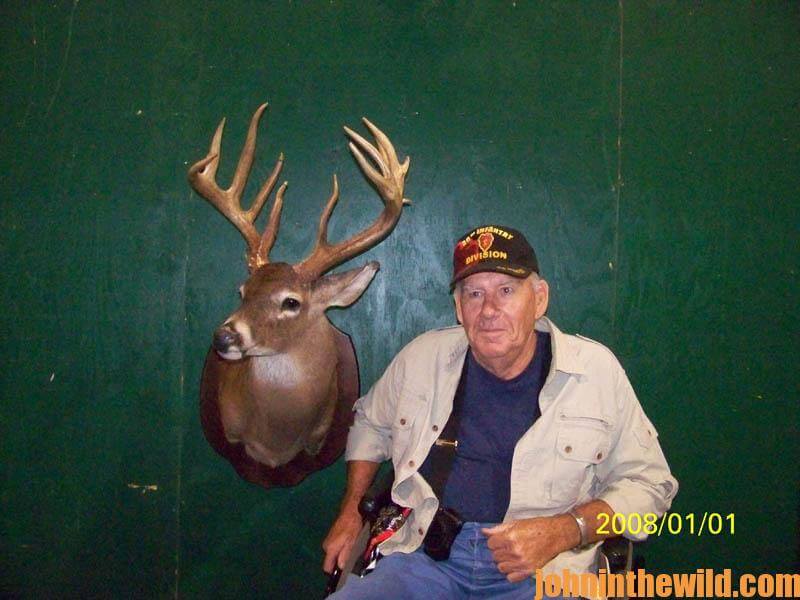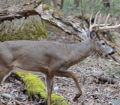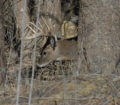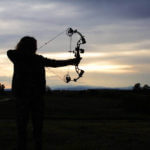John’s Note: Finding and taking a big deer is a process of connecting the dots with the knowledge you’ve learned from people who consistently take big bucks. Sure, some of the hunters who bag big deer just got lucky. But others have put together tactics that regularly produce trophy bucks. See if you can connect the dots this week of these featured deer hunters.
 Sixty-six year old Bobby Cook of Carbon Hill, Alabama, took his buck of a lifetime on January 24, 2014, in Fayette County, Alabama. But Cook’s story is like few others. On April 2, 1974, while riding his motorcycle, Cook was struck by a hit-and-run driver and paralyzed from the waist down. Cook had deer hunted before his accident on 1,400 acres, taking several bucks and does where he owned a portion of the land and leased the rest. After Cook’s accident, he didn’t hunt at all for 10 years. Then in 1984, “I purchased a 4-wheeler with hand controls,” Cook explains. “However, I had difficulty hunting from the 4-wheeler and using ground blinds. I got so cold that the hunting was miserable.”
Sixty-six year old Bobby Cook of Carbon Hill, Alabama, took his buck of a lifetime on January 24, 2014, in Fayette County, Alabama. But Cook’s story is like few others. On April 2, 1974, while riding his motorcycle, Cook was struck by a hit-and-run driver and paralyzed from the waist down. Cook had deer hunted before his accident on 1,400 acres, taking several bucks and does where he owned a portion of the land and leased the rest. After Cook’s accident, he didn’t hunt at all for 10 years. Then in 1984, “I purchased a 4-wheeler with hand controls,” Cook explains. “However, I had difficulty hunting from the 4-wheeler and using ground blinds. I got so cold that the hunting was miserable.”
Cook’s twin brother, Billy, drove an old International Harvester truck back and forth to work but decided to sell it. Bobby bought the truck. With his older brother Charles’ help, they completely rebuilt the truck, with a used Chevrolet engine and transmission, since no parts were available for the International Harvester. Bobby and Charles put in hand controls, added a Big Buddy propane heater to the floorboard, jacked the frame up for more road clearance and added mudder tires to go anywhere there was an opening.
With Cook’s customized truck, he then could drive down logging roads, back the truck into the trees and brush and hide. He could cut shooting lanes to enable him to see out the windows of the truck for at least 120 or 130 yards and up to 500 yards on the edges of clear-cuts. Cook practiced shooting his .300 Magnum until he was deadly accurate from zero to 500 yards. He would rest the forearm of his rifle in the palm of his hand and laid his hand on the rolled-down truck window for a steady rest.
Today Cook uses eight trail cameras on places where he’s seen deer tracks crossing logging roads, going to green fields and moving in and out of clear-cuts. From his trail-camera surveys and the 15 years he’s hunted this same property from his modified truck, Cook has learned to pattern the deer and identify the trails the deer use to travel to and from feeding, bedding and mating sites.
 During the 2013-2014 Alabama deer season, Cook didn’t hunt very much due to back problems. Then he invited two friends from Pennsylvania, Wes McDonald and Pete Skrgic, to come and hunt the last few days of deer season with him. On January 24, 2014, Cook drove his truck down an old logging road where he’d found a fresh deer trail that deer were using to come down a hill and cross the logging road to reach a hardwood creek bottom. They then would walk about 100 yards to reach a green field where they fed after dark. Cook had hunted this same trail for 5 years and had taken eight bucks and six does there, with one buck green scoring 152 points and another 158 points. Cook, his family and his friends consistently harvested mature, older-age-class bucks on this property, since they passed on young bucks until they were fully mature. Cook never got out of his truck when hunting, so he never left human odor anywhere. He always hunted with the wind in his face too.
During the 2013-2014 Alabama deer season, Cook didn’t hunt very much due to back problems. Then he invited two friends from Pennsylvania, Wes McDonald and Pete Skrgic, to come and hunt the last few days of deer season with him. On January 24, 2014, Cook drove his truck down an old logging road where he’d found a fresh deer trail that deer were using to come down a hill and cross the logging road to reach a hardwood creek bottom. They then would walk about 100 yards to reach a green field where they fed after dark. Cook had hunted this same trail for 5 years and had taken eight bucks and six does there, with one buck green scoring 152 points and another 158 points. Cook, his family and his friends consistently harvested mature, older-age-class bucks on this property, since they passed on young bucks until they were fully mature. Cook never got out of his truck when hunting, so he never left human odor anywhere. He always hunted with the wind in his face too.
“Here’s another advantage that I have,” Cook says. “I sit perfectly still in my truck, leaving some of the truck’s hood exposed on the road and positioning it 120-130 yards from the spot where I expect the deer to appear. When the deer come down the trail and step out on the logging road, they’re not threatened by the truck but usually look at it, while standing still and broadside to me.”
On January 24, Cook had backed his truck off the road behind three cedar trees and cut a shooting lane through the branches of the cedar trees, making him almost invisible. At 3:30 pm, Cook spotted three does coming down the trail to the logging road. When the does stepped in the road, Cook saw a huge buck standing behind them. “Instantly, I knew this buck was a shooter buck,” Cook reports. “I didn’t have time to look at his antlers and count the points. But I aimed through my scope at the doe standing in front of the big buck.” The doe walked off, giving Cook a clear shot at the buck. However, the buck raised his head and spotted the truck. By the buck’s posture, Cook realized the deer was about to leave the road. He aimed for the deer’s shoulders, hoping that the knock-down power of the .300 Magnum would break both shoulders and put the buck down quickly and efficiently. At the report of the rifle, the buck humped up and ran off the road.
“After the shot, I sat in my truck for a little while, not wanting to disturb anyone’s hunt,” Cook says. “Then once I reached the place where the buck had been was standing, I saw hair and blood and knew I’d made a good hit. I assumed the deer would go toward the little creek in the bottom.”
The hunters all carried cell phones. Cook called Skrgic and told him he’d shot a nice buck but to remain in his stand until dark. He also called a friend and his brother who were hunting with him that day and asked them come, blood trail the deer before dark and drag the huge buck out.
Once Cook finally saw how big the 13-point buck and his rack (grossed 177-5/8) were, he realized this was his buck of a lifetime but perhaps not. “Last season I got pictures of an 8-pointer I’d never seen,” Cook reports. “That buck may break the Alabama state record for an 8-pointer”
* BTR Score – Buckmasters’ Composite Score – Number of Inches: 177-5/8
* Official Buckmasters’ Score: 160-1/8 (doesn’t include inside spread of main beams)
To learn more about hunting deer, see John E. Phillips’ eBooks and print books at www.amazon.com/author/johnephillips and www.barnesandnoble.com. John’s newest deer-hunting book, “Whitetail Deer and the Hunters Who Take Big Bucks” is available at http://amzn.to/2bYwYOK/.










